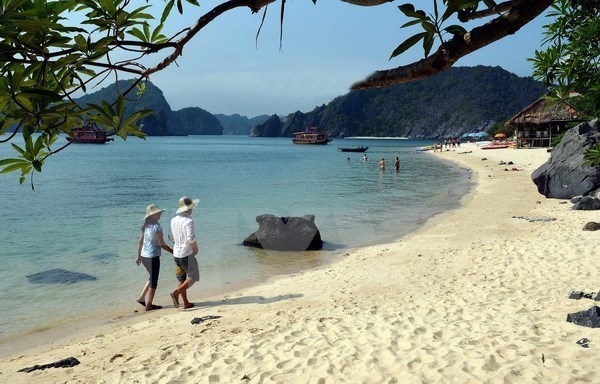



A beach on Khi (Monkey) Island of Cat Ba archipelago in Hai Phong
(Photo: VNA)
In the first half of this year, Cat Ba Island welcomed more than 1.5 million
visitors. Holidaymakers arrived even in the winter, said Vu Tien Lap – head of
the culture, sports and tourism division of Cat Hai district.
This sharp rise was partly attributed to the considerable improvement in local
infrastructure, which also saw the opening of Cat Bi International Airport and
Ha Noi – Hai Phong Expressway in recent years.
With tourism considered a key economic sector, the city has been working to
attract big investors to develop tourism facilities.
At a recent meeting of municipal officials, Secretary of the Hai Phong Party’s
Committee Le Van Thanh reiterated the necessity of building infrastructure
serving tourism development.
He noted that the city hopes to attract 7.5 million tourists by 2020. This
figure rose from 5.96 million in 2016 to 6.71 million in 2017. It reached 3.41
million between January and June and is expected to hit 7.79 million this year.
Major developers like SunGroup, Vingroup and Flamingo have been building
five-star hotels and other tourism facilities in Cat Ba and other places in the
city. In 2019, Sungroup plans complete a 5.1km-long cable system from Cat Hai
town to Phu Long commune and carry out a tourism project in Cat Ba.
The city sees beautiful landscapes, world-class tourism facilities and modern
infrastructure as key to luring vacationers. Meanwhile, ensuring security and
safety for tourists and service to their satisfaction will persuade them to
return to Hai Phong.
Local tourism has also benefited from the city’s investment attraction policy,
which has resulted in a big number of foreign workers arriving. About 2,000
experts have come to build automobile and mobile phone factories in Cat Hai.
Many others from Japan, the Republic of Korea, the US and Europe have also
stayed here to work on other investment projects.
In its development plans, the tourism sector of Hai Phong hopes to increase
coordination with relevant agencies to improve tourism quality. It will also
try to attract investors to make the city a key tourism destination of Vietnam.
Source: VNA